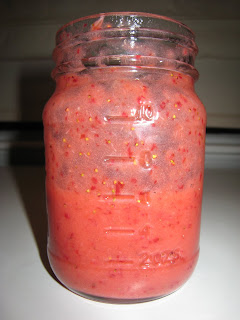 |
| Strawberry cupcakes with mascarpone frosting |
 |
| Strawberry cupcakes with strawberry mascarpone frosting |
Last month was my sister’s birthday. We hardly ever see each other on our birthdays since we live in different states. But this year we happened to both be visiting my parents on her birthday weekend.
My sister has quite a sweet tooth so I wanted to make her a special treat for her birthday. My first thought was chocolate because she is a total chocoholic. But we were at the very beginning of strawberry season so those yummy red berries were all I could think about.
I decided on the strawberry cupcakes from Martha Stewart’s
Cupcakes book. Martha did not lead me astray. The cupcakes were really good, not too sweet and bursting with small chunks of ripe strawberry. But the real winner was the frosting. Or, I should say, the frostings...plural.
Martha pairs her strawberry cupcakes with a strawberry buttercream. The buttercream recipe involves heating egg whites and sugar over a double boiler before beating the mixture and incorporating the strawberry puree. I was pressed for time so I flipped through her book for an easier recipe.
I found one for mascarpone frosting that was right up my alley. Mascarpone is an Italian triple crème cheese. It’s incredibly mild and almost sweet (though you can also use it in savory dishes). If you’ve had tiramisu, you’ve had mascarpone. All I had to do was combine mascarpone with sugar and vanilla and then fold in whipped heavy cream. I figured I’d just add in the strawberry puree as well.
The first night I served the cupcakes my sister requested that I leave out the strawberry puree. I did, and the cupcakes were delicious. Plus the frosting piped beautifully so the cupcakes looked as good as they tasted.
The next night, my brother-in-law asked me to mix the strawberry puree into the frosting. I thought it might be strawberry overkill, but I was wrong. Everyone loved it. The strawberry mascarpone frosting tasted just like Haagen Daaz strawberry ice cream (read: delicious!) The frosting was a lot droopier with the puree mixed in, but what it didn’t have in looks it more than made up for in flavor!
For the cupcakes, first finely chop your strawberries. The flavor of the strawberries really shines in this recipe so use ripe, sweet berries.
Combine your dry ingredients. In another bowl, cream the butter, sugar and vanilla, then add the eggs one at a time.
Now alternate adding the milk and dry ingredients while the mixer is running.
Fold in the chopped strawberries.
Fill your cupcake liners with the batter (don’t fill them more than 2/3 full or they will overflow like mine did).
Bake until golden brown (see all those yummy bits of strawberry in there?)
Now on to the frosting. Combine the mascarpone, vanilla extract and confectioner’s sugar until smooth.
In another bowl, whip your heavy cream until it forms stiff peaks.
Then gently fold the whipped cream into the mascarpone, a little at a time.
I broke out my new
Wilton cupcake froster for the job…
…and ended up with these beautifully frosted cupcakes.
On the second night we went for the strawberry mascarpone frosting. To make strawberry mascarpone frosting, puree your strawberries in the blender. Strain through a fine sieve to get rid of the little seeds.
Fold the puree into the mascarpone frosting. The frosting loses it’s structure when you add the puree but trust me, the flavor is worth it!
Whichever frosting you choose, these cupcakes will be gone before you know it!
Strawberry Cupcakes with Two Frostings
Recipe adapted from Martha Stewart’s
Cupcakes
For the cupcakes:
2¼ cups all-purpose flour
½ cup cake flour
1 Tbsp. baking powder
1 tsp. salt
2 sticks (1 cup) unsalted butter, at room temperature
2¼ cups sugar
1½ tsp. vanilla extract
3 large eggs plus 1 large egg white
1 cup milk
2½ cups finely chopped fresh strawberries*
1. Preheat the oven to 350˚ F. Line cupcake pans with paper liners.
2. In a medium bowl, combine the all-purpose flour, cake flour, baking powder and salt; whisk to blend.
3. In the bowl of an electric mixer, combine the butter, sugar and vanilla. Beat on medium-high speed until light and fluffy, about 3 minutes.
4. Beat in the eggs and egg white one at a time, mixing well after each addition and scraping down the sides of the bowl as needed.
5. With the mixer on low speed, add the flour mixture in two additions alternating with the milk, mixing each addition just until incorporated. Gently fold in the chopped strawberries with a spatula.
6. Divide the batter between the paper liners, filling each about ¾-full. Bake until light golden and a toothpick inserted in the center comes out clean, about 25-28 minutes, rotating the pans halfway through baking.
7. Allow to cool in the pans a few minutes, then transfer to a wire rack to cool completely.
Makes 34 cupcakes.
Mascarpone Frosting
1 cup heavy cream
8 ounces mascarpone cheese, at room temperature
1 tsp vanilla extract
1/2 cup confectioner's sugar, sifted
1. With an electric mixer on medium speed, whisk heavy cream until stiff peaks form (be careful not to overbeat, or cream will be grainy).
2. In another bowl, whisk together mascarpone and confectioners' sugar until smooth.
3. Gently fold whipped cream into mascarpone mixture until completely incorporated. Use immediately.
Makes 2 cups
Strawberry Mascarpone Frosting
1 recipe mascarpone frosting (see above)
1 cup fresh strawberries, chopped
1. Puree strawberries in a blender.
2. Strain through a fine mesh sieve.
3. Gently combine with mascarpone frosting.
























































